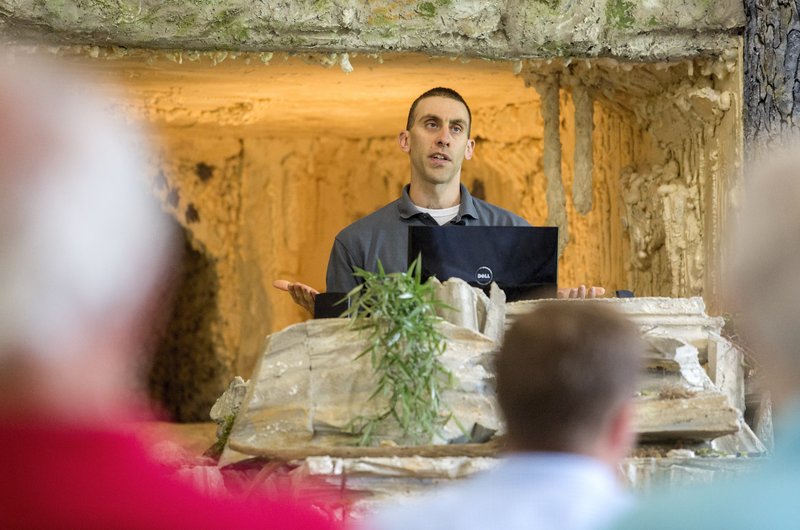CAVE SPRINGS -- The Illinois River Watershed Partnership is using a $286,000 grant from the Arkansas Natural Resource Commission to build a phosphorus removal structure, which is aimed at improving the quality of drinking water in the watershed, the executive director of the partnership said Friday.
The structure, on a tributary to Osage Creek, should be completed next week, said Delia Haak, the executive director of the partnership. About $12,000 from the grant will be set aside for maintenance of the structure, she said.
"This is new technology, and this project is all based on research," she said. "We want sound science, and once we have data, we can install more of them."
Phosphorus removal structures are landscape filters landowners can use to dissolve phosphorus in rain runoff. The structures use industrial byproducts, including material produced during water treatment, power generation and steel production, that absorb phosphorus from passing water.
While phosphorus and other nutrients, such as nitrogen and carbon, are necessary for a healthy aquatic system, in excess, they promote the growth of algae, which contaminates drinking water, said Andrew Sharpley, a professor at the University of Arkansas who has worked with phosphorus for the past 35 years.
"The bottom line is that everybody wants to reduce phosphorus getting into the Illinois River," Sharpley said. "There's a lot of proactive efforts going on. We all live in the watershed, and we all have to do our part."
Phosphorus flows into the watershed primarily in runoff from poultry farms and wastewater from municipal plants.
Installing phosphorus removal systems is voluntary, but they could become useful if the Environmental Protection Agency tightens pollution regulations, Sharpley said.
In 2012, the Watershed Partnership collaborated with researchers from Oklahoma State University and received a Conservation Innovation Grant worth $132,823 from the Natural Resources Conservation Service to build a phosphorus removal structure on a poultry farm in Oklahoma, Haak said.
"Multiple partners increase your chances of getting selected for a grant," she said. "When you have multiple partners, you have a greater return on investment, and it's easier to disseminate data and information."
Though the structures can be built in various forms, they typically cost about $5,000 to build and $1,000 in annual maintenance, said Chad Penn, an associate professor of soil and environmental chemistry at OSU who helped design and build the structure in Stillwater, Okla.
"It seems like a lot of money, but if you compare it with other methods of removing phosphorus, it's not too bad," he said. "Think about what it'll cost us if this problem gets worse."
Penn was referring to the blue-green algae toxin that contaminated drinking water in Toledo, Ohio, last year. Economists estimated the cost to the Toledo economy was around $40 million, Penn said.
Phosphorus removal structures have also been built in Maryland, Ohio and Vermont, he said.
The effectiveness of the structures depends on a variety of factors, including water flow, site conditions, structure design and the amount of phosphorus in the water, Penn said.
"We're trying to make it as easy as possible for people to be able to build these things," Penn said. "All the work we do here, the research and the educational programs, is somewhat pointless if we can't disseminate it and people can't go out and do it."
The partnership's grant, which was received in July 2014, is also being used to pay for other low-impact development projects, such as permeable pavement that reduces runoff by allowing water to seep into the soil, said Becky Roark, the partnership's project manager.
The Illinois River Watershed Partnership was founded in 2005 by residents of the watershed and researchers from UA and OSU. The Illinois River flows through Northwest Arkansas and Oklahoma. The partnership works to protect and improve the quality of the watershed through public education, community outreach, water quality monitoring and restoration techniques.
NW News on 05/30/2015
